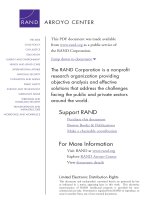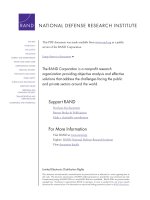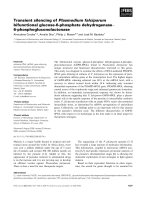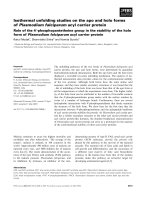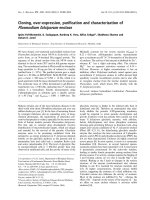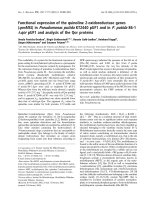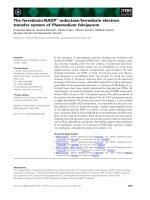Functional analyses of plasmodium falciparum primary metabolic genes
Bạn đang xem bản rút gọn của tài liệu. Xem và tải ngay bản đầy đủ của tài liệu tại đây (12.27 MB, 312 trang )
FUNCTIONAL ANALYSES OF PLASMODIUM
FALCIPARUM PRIMARY METABOLIC GENES
CHAN KOK LEONG MAURICE (MSc)
A THESIS SUBMITTED FOR THE DEGREE OF
DOCTOR OF PHILOSOPHY
DEPARTMENT OF MICROBIOLOGY
NATIONAL UNIVERSITY OF SINGAPORE
.
FUNCTIONAL ANALYSES OF PLASMODIUM
FALCIPARUM PRIMARY METABOLIC GENES
CHAN KOK LEONG MAURICE
NATIONAL UNIVERSITY OF SINGAPORE
2007
.
FUNCTIONAL ANALYSES OF PLASMODIUM
FALCIPARUM PRIMARY METABOLIC GENES
MAURICE CHAN 2007
.
Acknowledgements
It was my extreme good fortune to have worked under the guidance of
Professor Sim Tiow-Suan, who is simply the best teacher and mentor one could ever
hope for. I wish to thank Prof. Sim for the opportunities for professional and personal
development that have been provided in her laboratory. Her support, guidance and
encouragement provided are deeply appreciated. Having been Prof. Sim’s honors
student and postgraduate twice (an MSc was also accomplished under her guidance),
there is still so much more yet to be learnt from her. Prof. Sim’s creative energy and
wisdom will continue to inspire future endeavors. Her spirit to accept new challenges
and advanced expertise in many areas have allowed me to be exposed to an
impressive scope of biomedical research, ranging from antibiotic biosynthesis to the
molecular biology of malaria parasites. I am also indebted to her for always finding
time to advise the project amidst her heavy schedule in administration, teaching, and
even while guiding other lab members to do equally if not more outstanding work, in
areas of molecular studies on malaria kinases and proteases for example. Truly she
exemplifies that success means doing far beyond what is good enough.
Special thanks to staff and graduate students from the lab – Doreen, Jasmine,
Ling, Jason, Yu Min, Wenjie, Chun Song, and Hui Yu – for their encouragement,
advice and insightful discussions. Thanks also to Ms Seah Keng Ing for her excellent
technical support. These friendships have made working in the lab tremendously
enjoyable and memorable. The happy times together will be missed. Last but not
least, I am grateful to my wife Michelle and my family for their encouragement and
for understanding the heavy work commitment of a researcher.
.
i
Table of Contents
Acknowledgements i
Table of contents ii
Summary v
List of tables viii
List of figures ix
List of abbreviations
xi
Chapter 1 Introduction
1.1 The global malaria situation 2
1.2 Primary metabolic enzymes as potential drug-
targets
8
1.3 The Apicomplexans 11
1.4 Objectives of this study 15
Chapter 2 Molecular and biochemical aspects of P.
falciparum infection
2.1 Host invasion 21
2.2 Glycolytic pathways 25
2.3 TCA cycle and mitochondria 36
2.4 Electron transport 40
2.5 Other metabolic pathways
2.5.1 Fatty acid synthesis 42
2.5.2 Amino acid utilization and redox
metabolism
43
2.5.3 Nucleotide and nucleic acid synthesis 44
2.6 Protein trafficking 47
Chapter 3 Global studies on P. falciparum
3.1 Malaria research in the post-genomic era 51
3.2 Genome sequence of P. falciparum 52
3.3 Transcriptome and proteome 57
3.4 Structure based drug discovery 59
Chapter 4 Status and outlook of malaria drug-targets
4.1 The need for new anti-malarial drugs 64
4.2 The steps in drug discovery research 65
4.3 Identifying and validating drug-targets 69
4.4 Metabolic pathways as drug targets 74
4.5 Targets in the digestive vacuole 75
4.6 Targets in primary metabolic pathways 76
Chapter 5 Material and methods
5.1 Organisms and vectors 81
5.2 Culture conditions 81
.
ii
5.3 Media, buffers and solutions 82
5.4 DNA amplification and RT-PCR 82
5.5 Vector construction for heterologous
expression in E. coli
87
5.6 Vector construction for mammalian cell
transfection using Gateway technology
87
5.7 Electro-transformation of E. coli 89
5.8 Restriction digestion and ligation of DNA 90
5.9 Agarose gel electrophoresis 90
5.10 DNA sequencing 91
5.11 Growth and induction of E. coli cells 91
5.12 Sds-polyacrylamide gel electrophoresis of
total proteins
92
5.13 Preparation of cell-free extracts 93
5.14 Protein purification and enzyme assays 95
5.15 Mammalian transfection and confocal
microscopy
97
5.16 Yeast two-hybrid screening 98
5.17 Transformation of yeast cells 100
5.18 Computational analyses and accession
numbers
101
Chapter 6 Identification of potential targets for functional
studies
6.1 Overview 104
6.2 Target selection 105
6.3 Cloning of selected targets into expression
vectors
112
6.4 Recombinant expression of selected targets as
fusion partners
115
Chapter 7 Functional expression of recombinant proteins
from P. falciparum
7.1 Prelude 123
7.2 Relevance of ICDH as a potential drug-target 123
7.3 Sequence analysis of P. falciparum ICDH 124
7.4 Biochemical characterization of P. falciparum
ICDH
126
7.5 Relevance of mdh as a potential drug target 135
7.6 Sequence analysis of P. falciparum MDH 136
7.7 Biochemical characterization of P. falciparum
MDH
138
7.8 Relevance of P. falciparum PK1 as a potential
drug-target
145
7.9 Sequence analysis of P. falciparum PK1 146
7.10 Kinetic characteristics of overexpressed PK1 148
Chapter 8 Transcription analyses of targets and protein
interaction
8.1 Transcription analysis 161
8.2 Authentication of another copy of pyruvate
kinase (PK2)
168
.
iii
8.3 Structural comparison between PK1 and PK2 169
8.4 PK2 appears to be confined to apicomplexans 171
8.5 Evaluation of yeast-two-hybrid for screening
plasmodial protein interaction
179
Chapter 9 Evaluation of plasmodial protein localization using
a relevant live-cell system and protein-interaction
screening
9.1 Relevance of protein localization in drug-
target validation
187
9.2 Computational analyses of plasmodial
mitochondria transit peptides in comparison
with eukaryotic sequences
190
9.3 Targeting gfp fusion proteins to the
mitochondrial network of CHO-k1 using
ICDH, CS, BCKDH, and SDH N-terminal
signals
192
9.4 Localization of the nuclear localization
signals (NLSs) from HDAC and RPOL, and
the apicoplast-targeting signals from PK2 and
GDH
194
Chapter 10 Discussion
10.1 Heterologous expression of malarial ORFs 204
10.2 Isocitrate dehydrogenase (pfICDH) 208
10.3 Malate dehydrogenase (pfMDH) 210
10.4 Pyruvate kinase 1 (pfPK1) 212
10.5 Localization and protein interaction 216
10.6 Concluding remarks and future directions
10.6.1 Exploiting primary metabolic enzymes
as potential drug-targets
221
10.6.2 Heterologous expression of primary
metabolic genes
222
10.6.3 The prospects of surrogates and
orthologues
224
10.6.4 The current status of glycolytic and
TCA cycle genes
226
Appendix I 230
References 233
List of publications 259
.
iv
Summary
The exploitation of malarial primary metabolic genes as drug-targets has been
neglected, partly because early biochemical studies have suggested the absence of a
functional TCA cycle in Plasmodium falciparum. However, datamining of the malarial
genome revealed a cohort of DNA sequences that support a potential network of extensive
glycolytic and TCA pathways. Thus, this study took the challenge of questioning the
existence of these genes and their physiological roles.
To start off, a selection of 10 predicted genes encoding primary metabolic enzymes
were cloned and tested for expression as fusion proteins partnered with glutathione-S-
transferase (GST), maltose binding protein (MBP), or thioredoxin (Trx) tags
1
. Results
indicated profound differences in expression levels, peculiar to each target or the fusion
partner used. Five of the targets could be solubly expressed using GST, resulting in the
authentication of three enzymes, ie, isocitrate dehydrogenase (ICDH), malate dehydrogenase
(MDH) and pyruvate kinase 1 (PK1). GST, MBP and Trx were unable to coax the expression
of the other five selected genes. Comparison of gene sequences coding for these plasmodial
proteins revealed no clear justification to cite the influence of codon bias, instability index, pI,
frequency of coiled-coils, or hydrophobicity on their ability to communicate soluble
expression. The frustration in scarce soluble expression of plasmodial genes is widely
encountered. Despite the expected hitch, the three soluble and active recombinant malarial
proteins procured in this study were subjected to biochemical analyses to evaluate their status
as metabolic enzymes. Further, in order to trace the functions of the non-enzymatic proteins
linked to primary metabolism, the use of a selection of heat shock proteins, also cloned in this
study, as baits in yeast-two-hybrid screening led to the identification of an interaction between
a small heat shock protein (hslv) and a previously identified receptor for activated kinase
(PfRACK). However, how PfRACK might impact the parasite’s signaling and regulation
remains to be investigated.
1
The 10 targets were glycerol-3-phosphate dehydrogenase, glycerol kinase (GK), pyruvate kinase 1 (PK1),
fumarase (FUM), citrate synthase (CS), isocitrate dehydrogenase (ICDH), malate dehydrogenase (MDH),
glutamate dehydrogenase (GDH), dihydroorotase (DHO), and inosine-5’-monophosphate dehydrogenase.
.
v
To inquire whether the 10 candidate genes were expressed during the
intraerythrocytic stages, in vitro blood cultures of the parasites were invoked and, via RT-
PCR, all the ORFs were found to be actively transcribed. Unexpectedly, a second pyruvate
kinase (PK2) which may have a unique function in the apicoplast was identified in these
experiments. In addition, in search of a link between glycolysis and the TCA pathway, the
transcription profiles of 15 glycolytic and 11 TCA cycle genes were extracted from a web-
based microarray data. Interestingly, the survey revealed that two enzymes typical of
mitochondrial activity ie. MDH and fumarase (FUM), appeared to be cytosolically localized,
suggesting that they may have unusual links to the TCA cycle. Such revelations have raised
the importance of searching transcription data to correlate the homology-based annotations of
genome data.
The functions of eukaryotic proteins are widely defined by their compartments in an
organism. However, protein localization procedures involving transfection of parasites are
besotted with technical hurdles. Hence, there is a need for a simple assay to position identified
cellular targets. A combination of fluorescent markers, organelle-specific probes, phase
contrast microscopy, and confocal microscopy was used to locate a selection of
mitochondrial-, nuclear-, and apicoplast-targeting signal peptides from plasmodial proteins in
CHO-K1 cells
2
. The respective localizations of these malarial proteins have complied with the
selected molecular targets, viz. mitochondrial, nuclear and cytoplasmic. Interestingly, MDH
that is widely known to be resident in eukaryotic mitochondria was found to be cytoplasmic,
both by computational analysis and by this novel method of gene localization. The absence of
target sequences ahead of the MDH ORF provided molecular evidence of a protein not
destined for the mitochondria.
Taken together, this study has re-opened the search of a plausible network of primary
metabolic malarial genes, some of which have been defined by biochemical characterization,
protein-interaction studies, transcription analyses, and finally, by novel in situ localization of
2
These eukaryotic cells served as an in vitro living system for studying the cellular destinations of four
mitochondrial-targeted TCA-cycle proteins (CS; ICDH; branched chain α-keto-acid dehydrogenase E1α subunit;
succinate dehydrogenase flavoprotein-subunit), two nuclear-targeted proteins (histone deacetylase; RNA
polymerase), two apicoplast-targeted proteins (PK2; GDH), and two cytoplasmic resident proteins (MDH; GK).
.
vi
fluorescently-labeled malarial gene targets in eukaryotic CHO-K1 cells, to provide
endorsement of their proposed functional roles.
.
vii
List of Tables
Table 1-1. Examples of current malaria discovery and development projects and
associated organizations.
Table 1-2. Resource of malaria initiatives.
Table 1-3. Comparison of diseases caused by Apicomplexans which infect
humans.
Table 2-1. Status of research of glycolytic enzymes of P. falciparum.
Table 2-2. Summary of current status of research on genes encoding the three key
glycolytic enzymes hexokinase, phosphofructokinase, and pyruvate
kinase in P. falciparum, other Plasmodium spp., and other protozoan
parasites.
Table 2-3. Status of research of TCA cycle and related enzymes.
Table 2-4. Summary of evidence for and against the operation of the TCA cycle
in the erythrocytic-stages of P. falciparum.
Table 3-1. Comparison of current status and major findings of global studies on P.
falciparum.
Table 4-1. Desirable characteristics of a putative target.
Table 4-2. Summary of status of actively researched drug-targets from P.
falciparum.
Table 5-1 Organisms and vectors used in this study.
Table 5-2. Primer pairs used for the PCR amplification of genes employed in
bacterial expression and functional analysis.
Table 5-3. Primer pairs used for the PCR amplification of DNA fragments
employed for mammalian expression of GFP fusion proteins.
Table 5-4. Primer pairs used for the PCR amplification of genes employed as
baits for the yeast-two-hybrid study.
Table 5-5. Primer pairs employed for transcription analysis of FUM, GK, PK1
and PK2 by amplification of partial cDNA fragments.
Table 5-6. Solutions for SDS-PAGE.
Table 6-1. Genome data on glycolysis and related genes in P. falciparum.
Table 6-2. Genome data on TCA cycle and related genes in P. falciparum.
Table 6-3. Summary status of predicted genes selected for analysis in this study
(I): Predicted functions and nomenclature.
Table 6-4. Summary status of predicted genes selected for analysis in this study
(II): Predicted localizations.
Table 6-5. Expression data for all the targets as N-terminal GST-fusion proteins.
Table 6-6. Comparison of biophysical parameters of solubly expressed active
proteins to those which were not expressed.
Table 7-1. Effect of assay conditions on enzyme activity of pfICDH.
Table 7-2. Accession numbers and list of sequences used to compute the
phylogenetic tree for MDHs and LDHs.
Table 7-3. Enzyme kinetic parameters of pfPK1.
Table 8-1. Comparison of RT results with microarray and proteomics.
Table 8-2. Significant primary structural differences between PK1, PK2, and
human pyruvate kinases at their effector binding sites.
Table 8-3 Summary of yeast-two-hybrid confirmation results for bait R5 and
prey Q4.
Table 9-1. Comparison of mitochondrial localization prediction programs in the
prognosis of cellular localizations of a selection of P. falciparum
proteins.
Table 10-1. Current status for P. falciparum primary metabolic enzymes.
.
viii
List of Figures
Fig. 1-1. The Plasmodium life-cycle and its associated pathological processes.
Fig. 1-2. Overview of workflow in this project.
Fig. 2-1. Pathways of carbohydrate metabolism in P. falciparum.
Fig. 2-2. (a) TCA cycle; (b) mitochondrial respiratory chain metabolism
showing potential electron donors.
Fig. 2-3. (a) Hemoglobin degradation and its relation to redox pathways; (b)
Nucleotide synthesis pathway and its relation to folate synthesis.
Fig. 3-1. The relationship between molecular weight and expression of P.
falciparum proteins in E. coli.
Fig. 4-1. Drug discovery process leading to the pre-clinical and clinical trials of
a development train.
Fig. 4-2. Schematic representation of new and existing therapeutic targets in P.
falciparum depicted according to their sites of action.
Fig. 6-1. Metabolic map for the predicted pathways carried out by genes
selected for this study.
Fig. 6-2. PCR amplification and cloning of selected drug targets in pGEX-6p1.
Fig. 6-3. SDS-PAGE analysis of expressed recombinant proteins after affinity
purification from soluble E. coli fractions.
Fig. 6-4. Assessment of the impact of codon bias in expression of malaria
proteins by investigating the effect of RIG or RIL plasmids in
expression levels by SDS-PAGE analysis.
Fig. 7-1. Multiple alignment of pfICDH aa sequences with bovine, human and
E. coli ICDH sequences.
Fig. 7-2. Homology model of pfICDH (yellow) superimposed on the porcine
ICDH crystal structure (blue) used as the template for threading.
Fig. 7-3. Phylogenetic tree of ICDHs from prokaryotic and eukaryotic
organisms.
Fig. 7-4. Enzymatic activity and purification of pfICDH expressed in E. coli
BL21.
Fig. 7-5. Phylogenetic tree of MDHs and LDHs from prokaryotic and
eukaryotic organisms.
Fig. 7-6. Multiple alignment of pfMDH aa sequences with pfLDH, P. yoelii
MDH, T. gondii LDH, E. coli MDH, and human cytosolic MDH
sequences.
Fig. 7-7. (a) MDH enzyme activities of recombinant clones harboring pfMDH
gene and controls harboring vectors without inserts; (b) Effect of a
range of metabolites on pfMDH activity.
Fig. 7-8. (a) Homology model of pfMDH (yellow) superimposed on pfLDH
template used in threading (blue); (b) Model of pfMDH (yellow)
superimposed on porcine cytosolic MDH.
Fig. 7-9. Amino-acid sequence alignment of P. falciparum PK1 with pyruvate
kinases from other species.
Fig. 7-10. Phylogenetic (Neighbor-joining) tree constructed using pyruvate
kinase amino acid sequences.
Fig. 7-11. Determination of oligomerization state of PK1 by gel-filtration.
Fig. 7-12. Kinetic properties of PK1.
Fig. 7-13. Effect of various effector compounds on pfPK1 activity.
Fig 8-1. RT-PCR analysis of predicted ORFs selected for functional analysis.
Fig. 8-2. Transcription profiles of (a) glycolysis and (b) TCA enzymes extracted
from microarray data.
.
ix
Fig. 8-3. Comparison of transcription profiles of PK1 and PK2 based on existing
transcriptomics data.
Fig. 8-4. RT-PCR amplification of cDNA encoding PK1 and PK2.
Fig. 8-5. Comparison of the conserved domains of PK1 and PK2.
Fig. 8-6. Amino-acid sequence alignment of P. falciparum PK1 and PK2 with
pyruvate kinases from other species.
Fig. 8-7. Phylogenetic analysis of PK1 and PK2.
Fig. 8-8. Possible involvement of PK1 and PK2 in predicted lipid and glycolytic
metabolic pathways of P. falciparum.
Fig. 8-9 (a) Agarose gel electrophoresis of resultant ds cDNA library
synthesized from P. falciparum mRNA showing moderate strong
smear from approximately 0.25 kb to 5 kb (lane 2); (b) RT-PCR and
cloning of bait (hslv).
Fig. 8-10. Yeast-two-hybrid results for bait (R5) and prey (Q4).
Fig. 8-11 The partial receptor for activated C kinase (RACK) cDNA insert in
prey Q4 (highlighted) in relation to the full cDNA.
Fig. 9-1. Phylogenetic tree for mTPs from protozoan, animal, plant and fungal
sequences.
Fig. 9-2. Fluorescence microscope images of CHO-K1 cells transfected with
vectors expressing (a) CS-GFP, (b) ICDH-GFP, (c) BCKDH-GFP, (d)
SDH-GFP, (e) HDAC-GFP, (f) RPOL-GFP, (g) PK2-GFP, (h) GDH-
GFP, (i) MDH-GFP, (j) GK-GF.
Fig. 9-3. Confocal laser scanning images of CHO-K1 cells transfected with
vectors expressing (a) CS-GFP, (b) ICDH-GFP, (c) BCKDH-GFP, (d)
SDH-GFP, (e) MDH-GFP, and (f) GK-GFP, and subjected to in situ
staining using Mitotracker Red.
Fig. 9-4. Fluorescence microscope images of CHO-K1 cells co-transfected with
pDsRed2-Mito and vectors expressing (a) CS-GFP, (b) ICDH-GFP, (c)
BCKDH-GFP, (d) SDH-GFP.
Fig. 9-5. Fluorescence microscope images of CHO-K1 cells transfected with
vectors expressing (a) HDAC-GFP, (b) RPOL-GFP, (c) GK-GFP, and
stained with Hoechst 33342.
Fig. 10-1. Alignment of the binding site of the 6-phosphate moiety of F16BP
within the C-domain.
Fig. 10-2. Summary of the functional investigations, expression analysis, and
cellular localization observations obtained in this study.
.
x
LIST OF ABBREVIATIONS
aa Amino acid
ATCC American Type Culture Collection
CS Citrate synthase
DHO Dihydroorotase
ds Double-stranded
FUM Fumarase
GDH Glutamate dehydrogenase
GFP Green fluorescent protein
GK Glycerol kinase
GST Glutathione-S-transferase
HA Hemaglutinin
ICDH Isocitrate dehydrogenase
IMPDH Inosine-5’-monophosphate dehydrogenase
IPTG Isopropyl-1-thio-β-D-galactopyranoside
kDa Kilo Daltons
MBP Maltose binding protein
MCS Multiple-cloning sites
MDH Malate dehydrogenase
mTP Mitochondrial-targeting signal
NLS Nuclear localization signal
OD Optical density
ORF Open reading frame
PEP Phosphoenopyruvate
PGDH Glycerol-3-phosphate dehydrogenase
PK Pyruvate kinase
RBC Red blood cell
RT-PCR Reverse transcription polymerase chain reaction
SDS-PAGE Sodium dodecyl sulphate polyacrylamide gel electrophoresis
SOD Superoxide dismutase
TCA Tricarboxylic acid
Trx Thioredoxin
.
xi
Chapter 1
CHAPTER 1
INTRODUCTION
1
Chapter 1
2
CHAPTER 1 INTRODUCTION
1.1 THE GLOBAL MALARIA SITUATION
Malaria remains to be a major global problem, causing disease in 300-500
million people annually (Fidock et al. 2004). The disease kills 1-3 million people
each year, 1 million of whom are children of less than five years of age
(translating to one child every 40 seconds) (Kirchgatter and Del Portillo 2005).
Malaria is currently endemic in over 100 countries, putting 40% of the world’s
population at risk, particularly children, pregnant women, and non-immune
travelers. Although most parts of Asia and Americas are at relatively low malaria
risks, deaths from malaria continue to occur in rural or remote areas where
treatment is not available or adequate. Hence, malaria is clearly a disease of
poverty, with 90% of the cases occurring in Africa. The economic impact of
malaria on welfare and child survival further limits the ability of malarious states
to contribute to economy. Although there are vaccine initiatives (Table 1-2;
www.malaria-vaccines.org.uk), the disease is currently controllable through
vector control or bed nets, as well as drug treatment. However, the problem of
drug resistance is now so serious that the old affordable first line drugs such as
chloroquine and sulfadoxine-pyrimethamine are virtually useless in many parts of
Asia and Africa today (Bathurst and Hentschel 2006). The dwindling
effectiveness of frontline drugs suggests that new antimalarial drugs are needed
urgently so as to protect billions of people from this terrible disease.
Chapter 1
3
The basic investigation into the biology of malaria is crucial to the
development of new drugs and vaccines. Advancement in the understanding of
the structural and functional properties of plasmodial proteins is central to the
employment of these proteins as drug-targets in the drug-discovery process. Also,
educated lead development might come from molecular genetic studies. Hence,
this study involved the datamining, cloning and functional analyses of plasmodial
genes encoding metabolic enzymes that might be crucial for the parasite’s
survival, with the prospect of uncovering functional proteins that may be
employed as potential targets for anti-malarial drug-screening. Among the four
Plasmodium species that infect humans (Table 1-3), the most severe malaria is
caused by P. falciparum which is responsible for almost all the deaths resulting
from complications. Hence, this study is focused on functional genes from this
species. The landmark publication of the complete P. falciparum genome
(Gardner et al. 2002) with draft annotation in late 2002 has made it possible to
adopt the latest global-genome survey approaches for malaria research. It should
be emphasized that the exploitation of available global biological information
relies heavily on the verification of the annotation of plasmodial genes. In this
study, the validation of potentially important P. falciparum proteins was achieved
experimentally via recombinant expression and functional characterization.
Certain aspects of plasmodia metabolism are actively investigated as novel
targets, including the hemoglobin-processing, shikimate, redox, and primary
metabolic pathways (reviewed in Chapter 4). This study is focused on the
functional analysis of primary metabolic enzymes of P. falciparum, resulting in
the identification of P. falciparum isocitrate dehydrogenase (ICDH), malate
dehydrogenase (MDH), and pyruvate kinase (PK1) as potential drug-target
Chapter 1
4
candidates. Information on the cellular localization and/or protein-protein
interaction of specific target proteins is invaluable information relevant to the
validation of a specific target. The functions of proteins are defined in the context
of compartments that they are organized into, or the proteins they interact with.
In the latter part of this study, the need for a simple assay for validating the
cellular localizations of identified drug-targets was highlighted. As a result,
certain classes of signal peptides (ie. mitochondrial-targeting peptides and
nuclear localization signals) present on the primary metabolic proteins were
localized using a novel cellular-targeting assay. The suitability of a yeast-two-
hybrid system for assaying plasmodial protein interaction was also examined in
this study.
Currently, PlasmoDB (www.plasmoDB.org) is the central malaria
resource that enables intuitive browsing through the P. falciparum genome and
its annotated genes. Further integration of genomic information and experimental
data from transcriptomics, proteomics, “interactomics”, and “secretomics”
studies are facilitating the generation of a ‘virtual’ P. falciparum parasite (a list
of useful links to genome databases and several other interesting malaria websites
is illustrated in Table 3-1). Also, as a result of increased worldwide funding for
malaria research, an unprecedented number of malaria discovery projects and
initiatives involving many organizations are now underway (Table 1-1 and 1-2).
A significant event was the establishment of Medicines for Malaria Venture
(MMV) in Geneva in 1999. MMV is a not-for-profit organization that brings
together public, private and philanthropic partners to fund and manage the
discovery of affordable new antimalarials. Currently, MMV manages the world’s
Chapter 1
5
largest malaria research and development portfolio, covering the innovation
spectrum from basic drug-discovery to advanced clinical development (Bathurst
and Hentschel 2006).
Chapter 1
6
Table 1-1. Examples of current malaria discovery and development
projects and associated organizations.
Abbreviations: BMS, Bristol-Myers Squibb; CDRI, Central Drug Research
Institute, India; GSK, GlaxoSmithKline; LSHTM, London School of
Hygiene and Tropical Medicine; MMV, Medicines for Malaria Venture;
NIH, National Institutes of Health, USA; STI, Swiss Tropical Institute; TDR,
UDNP/World Bank/WHO Special Program for Research and Training in
Tropical Diseases; UCSF, U. California San Francisco; WRAIR, Walter
Reed Army Institute of Research.
Sources: MMV (website:
www.mmv.org) and Fidock et al. 2004.
Current malaria projects Associated organizations
Discovery projects
Fatty acid biosynthesis inhibition MMV, GSK
Cysteine protease inhibitors MMV, UCSF, GSK
Dihydrofolate reductase inhibition MMV, BIOTEC Thailand, LSHTM, Monash
U.
Protein franesyltransferase inhibitors MMV, BMS, U. Washington, Yale
New dicationic molecules MMV, U. North Carolina, STI
8-aminoquinolines MMV, U. Mississippi, NIH
4(1H)-pyridones back ups MMV, GSK
Chalcones National U. Singapore, Lica
Pharmaceuticals
Synthetic endoperoxides Johns Hopkins U., U. Laval, CDRI
Development projects
Pyronaridine artesunate MMV, TDR, Shin Poong
Chlorproguanil dapsone artesunate MMV, TDR, GSK, LSHTM
Artemisone MMV, Bayer, U. Hong Kong
Azithromycin chloroquine Pfizer
Short chain chloroquine U. Tulane
Tafenoquine GSK, WRAIR
Third-generation antifolates Jacobus
Chapter 1
7
Table 1-2. Resource of malaria initiatives.
Resource Website Funding
Medicines for Malaria
Venture (MMV)
Rockefeller Foundation, the
World Bank, the Swiss
Agency for Development and
Cooperation, the Wellcome
Trust
The Malaria Consortium ariaconsortium.
org/
WHO, UNICEF, Gates
Malaria Centre (Ghana),
Rotary Club
The Wellcome Trust
An independent charity fund
Malaria Vaccine Initiative
(MVI)
Bill and Melinda Gates
Foundation
National Institute of
Allergy and Infectious
Diseases (NIAID)
US government
Special Program for
Research and Training in
Tropical Diseases (TDR)
UNICEF, World Bank, WHO
Drugs for Neglected
Diseases (DNDI)
Médecins sans Frontières,
TDR, and five public sector
institutes
Chapter 1
8
1.2 PRIMARY METABOLIC ENZYMES AS POTENTIAL
DRUG-TARGETS
To date, antimalarial drugs are the only way to treat the disease. Although
a number of clinical and field trials of various malaria vaccines are ongoing, the
promise of an effective vaccine against malaria remains unrealized (Waters
2006). The parasite’s complex interaction with its host, as well as its ability to
undergo antigenic variation, appears to be chief obstacles to a malaria vaccine.
However, the widespread resistance to well established drugs has resulted in an
urgent need to identify and develop alternatives. Identifying novel drug-targets is
hence a major approach against malaria. Generally, enzymes and receptors are
found to be good drug targets, with enzymes accounting for 28% of all current
drug targets (Drews 2000).
The malaria parasite exhibits a rapid growth and multiplication rate
during many stages of its life-cycle. This necessitates that the parasite acquires
and metabolize biological molecules efficiently via crucial metabolic pathways
so as to survive and reproduce. Hence, understanding the parasite's metabolism
may lead to the development of novel therapeutic strategies which exploit the
unique yet indispensable metabolic pathways employed by the parasite. The
dependence of plasmodia upon glycolysis has inspired a fair amount of research
into inhibitors of this pathway. A key enzyme of this process, P. falciparum
lactate dehydrogenase (pfLDH), was one of the most advanced examples of
structure-based drug-design (Mehlin 2005). Comparison of its 3D structure with
the corresponding human structures revealed that selectivity was possible.
Indeed, a class of specific inhibitors (gossypol derivatives) has antiparasitic
Chapter 1
9
efficacies, although funding for drug-screening using pfLDH recently ended due
to the lack of a clinical candidate (
www.mmv.org). In contrast to pfLDH, other
key enzymes of the glycolytic pathway, such as hexokinase, phosphofuctokinase
and pyruvate kinase, have not yet been examined in detail, although enzyme
activities for all three enzymes have been detected in asexual-stage plasmodia.
Among the key glycolytic enzymes, only the gene encoding hexokinase has been
cloned (Olafsson and Certa 1994). In this study, a gene encoding pyruvate kinase
in P. falciparum was cloned and characterized.
Authentication of gene functions is a crucial step in validating predicted
metabolic pathways as well as the exploitation of specific enzymes for
therapeutic intervention. Although the publication of the entire genome of P.
falciparum is a major step forward in reaching a more comprehensive
understanding of Plasmodium metabolism, the information from the malaria
genome provides, at best, a scrambled image of all the biological functions
potentially available to the parasite. Hence, the challenge for malaria researchers
in the post-genomic era is to piece together the genomic jigsaw and obtain a
meaningful metabolic picture of the malaria parasite.
It is perhaps rather alarming that the biological basis even of major
antimalarials such as chloroquine and artemisinin are still not fully understood
(van Dooren et al. 2006). Currently, it is understood that chloroquine targets a
unique biochemical pathway of P. falciparum in the acidic food vacuole of the
parasite, where heme released during metabolism of hemoglobin mineralizes to
inert hemozoin (Egan et al. 2002). Chloroquine accumulates in the food vacuole
Chapter 1
10
and appears to block heme biomineralization by forming lipophilic, cytotoxic
chloroquine-heme complexes that kill parasites by permeabilizing cell
membranes (Egan et al. 2002). However, chloroquine frequently fails owing to
widespread resistance. Chloroquine resistance is linked to a K76T mutation in
PfCRT, a drug/metabolite transporter located on the food vacuolar membrane
(Cooper et al. 2002). It is believed that mutated PfCRT acts as a transporter of
chloroquine, enabling it to leave the food vacuole in which the drug accumulates
(Sanchez et al. 2007). The emerging resistance to chloroquine is the basis for this
thesis.
Functional studies involve the cloning of individual genes encoding these
enzymes, the production of pure and enzymatically active recombinant proteins,
and the execution of specific biochemical assays. Hence, detailed biochemical
characterization and physiological studies are components of the drug-target
validation process aimed at verifying the physiological roles and exploitability of
selected putative targets. Experimental observations on the cellular localization
and/or protein-protein interaction of specific target proteins are also relevant to
the validation of a specific target. These approaches were hence adopted for the
investigation of the primary metabolic enzymes in this study. However, the
composition of the malarial genes often presents technical problems during gene
cloning, and the expression of procured genes must be overcome before active
recombinant enzymes can be obtained (discussed in Section 3.4). In the next
chapter, the major aspects of parasite metabolism according to the classes of
biomolecules will be discussed, with emphasis on the unique features of the
parasite’s enzymes.
Chapter 1
11
1.3 THE APICOMPLEXANS
The phylum Apicomplexa includes human parasites of the genera
Plasmodium, Toxoplasma, Babesia, and Cryptosporidium. An important feature
of all apicomplexan parasites is the presence of a specialized apical complex,
which is central to the invasion process. While Toxoplasma and Cryptosporidium
pass directly between vertebrate hosts (Table 1-3), the life cycles of Plasmodium
and Babesia involve an arthropod vector that transmits the parasite to a vertebrate
host during blood-feeding. Babesia is a malaria-like protozoan that also lives and
reproduces inside red blood cells (RBCs). Infection by this agent is often
misdiagnosed as drug-resistant malaria. However, unlike malaria, Babesia
infection (babesiosis) occurs only occasionally in man by accidental intrusion
into a natural disease cycle of certain animals.
Plasmodium species that infect humans share a similar life cycle, the
stages of which are depicted in Fig. 1-1. The haploid sporozoites enter the
bloodstream with the saliva of a feeding mosquito (Anopheles gambiae). After
invasion of a liver cell, the parasite undergoes a period of growth, followed by
multiple genome replications and mitotic divisions resulting in the production of
>20,000 daughter parasites (merozoites) that enters the circulation and invade
erythrocytes after release from the hepatocyte. After a period of intra-erythrocytic
development, several mitotic divisions result in the production of 16-32 new
merozoites per parasite (see also section 2.1). The duration of the erythrocytic
cycle and the number of merozoites produced are species specific. The asexual
blood-stage parasites are the cause of pathology. In the blood, a small percentage
of parasites develop into sexually committed cells, the female and male

